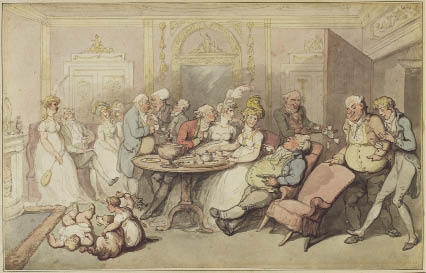Drawing Attention
Dulwich Picture Gallery, until 17 January
Last chance to see a really excellent selection of works on paper from the Art Gallery of Ontario in Canada. It’s a relatively new collection, begun in 1969, but despite that it includes many of the great names of Western art. From the Italian Renaissance to 18th-century France via England and the Netherlands, from German Expressionism to international abstraction, not forgetting a group of works by some of Canada’s finest, the collection maintains a hearteningly high standard.
In the first room are the Italians, so good it’s difficult to know where to start. Stroll round the room a couple of times and see what particularly catches your eye. I was much taken by Guercino’s crumbly-faced witch accompanied by two bats and a demon in flight. What economy of line and character evoked — there’s more humour here than evil. Another memorable drawing is ‘Satyrs and Satyresses in a Landscape’ by Giovanni Domenico Tiepolo (son of the more famous Giambattista), done in pen and brown ink with brown and grey washes. The compressed energy of the line is entrancing. A very different mood is captured by the beautifully balanced black chalk drawing ‘The Death of Hector’ by Gaetano Gandolfi. There’s also a lovely tough little brown ink drawing by Salvator Rosa (a foretaste of the solo show Dulwich is giving Rosa in the autumn) called ‘A Poet Seated by a Tree’, c.1640. The poet, with twigs in his hair (not laurel, but perhaps rosemary, for remembrance), labours at his task in the midst of nature.
Among the earlier French drawings in the second room are Boucher’s ‘Young Country Girl Dancing’, in chalks, a very charming and excellent example of draughtsmanship, and Charles-Joseph Natoire’s pleasingly theatrical ‘Park at Arcueil’. On the opposite wall is quite a different period: a sensitive pink gouache and watercolour transfer by Gauguin of a Tahitian girl. Its slight blurriness gives this modest image an unexpected depth of feeling. Also here is Vuillard (next to an extraordinarily precise ‘naturalistic’ drawing by Gleyre), who makes the face of a clown, Coquelin Cadet, out of an arrangement of flat colours. Degas gives us — incomparably — a dancer. A lovely Millet next to it, of women carrying bundles of dried grass, is infused with sensitivity. Further down there’s a drapery study by Ingres, an exquisitely hard, linear exploration of form. Below it a Delacroix, in a contrasting extreme of manic emotionalism.
Moving through into the Netherlandish and German drawings: the first image is a musical fantasy by the Master of the Egmont Albums, featuring St Cecilia and the Heavenly Chorus. Next to it is ‘The Judgment of Paris’ by Abraham Bloemaert; or, as a visitor wittily observed of the dimpled maidens, ‘The Master of Cellulite’. Nothing could be more calculated to point a contrast than the superb economy of the Rembrandt ink sketch of a quack which comes next. In fact, this room seems almost like a series of illustrations of different techniques, with an amazing array of textures in black chalk by Reinhart juxtaposed with Seydelman’s portrait in sepia wash. I don’t like the latter, but I can’t help admiring the mastery. Coming up to date, there’s a fine head of a young man by Adolph Menzel, a bleak and empty tavern by Käthe Kollwitz, miserabiliste avant la lettre, and a very solid early figurative drawing of farm buildings beside a canal by Mondrian. Finally, there’s a Van Gogh drawing of his old home in Holland.
The British drawings begin well with a Romney figure composition full of drama, hung above a typical Gainsborough pastoral. Rowlandson’s satire of long-necked women and pot-bellied men carries its expected punch, and a powerful double-sided Fuseli standing figure shows this artist’s deep kinship with Blake. There’s a rich, late Samuel Palmer sunset, an angry classical head by B.R. Haydon, typical precision in Ruskin’s watercolours of feathers and flowers, a rather effective study by Clarkson Stanfield of the eruption of Vesuvius, all billowing smoke and clouds of colour, and a very nice Bonington, exact in drawing and atmosphere. Then there’s a clutch of much duller 19th-century works before an injection of continental élan from the futurist Balla and the expressionist Schmidt-Rotluff. (His ‘Seated Nude’ has a gripping primitive vigour.)
The roll-call of the moderns continues impressively through Kandinsky, Ernst and Lissitzky to a seated charcoal figure by Matisse, on to Picasso, Léger, Masson (a very good example), and thence to a really lovely de Kooning (two women) and a tautly structured Pollock. In this company it’s rather surprising to discover Vanessa Bell, though thankfully she’s represented by the abstract decorative work (a screen) she’s best at. The show concludes with a group of five Canadian artists, the best of which is David Milne; his watercolour landscape is sheer liquid brilliance. It’s a pleasure to see drawing taken so seriously, though many of the later works are closer to paintings. Unreservedly recommended.






Comments